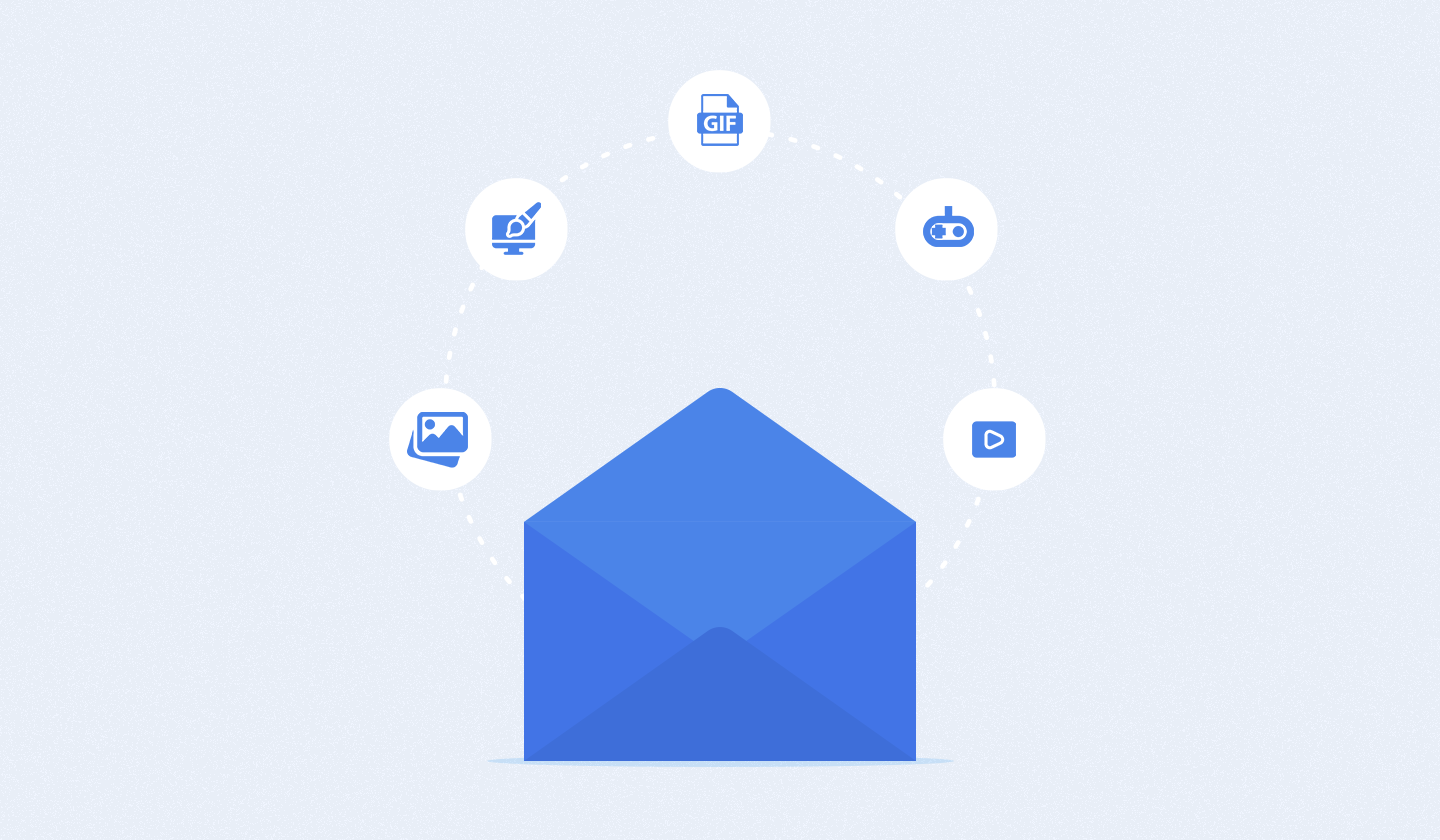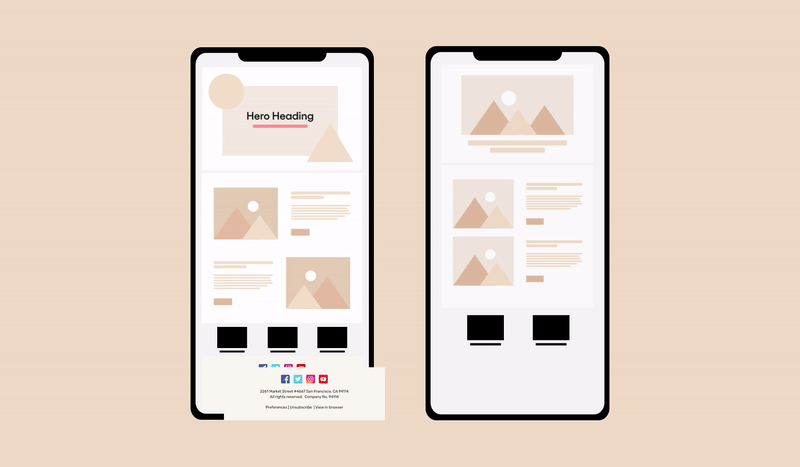A picture is worth a thousand words. But sometimes, you just need to spell things out. Sure, the right picture is definitely invaluable. However, add too many pictures, and that's just a roadmap for disaster.
Still, it's understandable why image-only emails seem so attractive. Pictures make everything more visually appealing. Also, when you can simply show what you want to say, why waste time writing it down?
But here's the punchline: image-only emails make for an awful subscriber experience. These emails will hurt your brand, land you in spam, and have readers unsubscribe - the list goes on.
If you're still not convinced, here are 8 more reasons why you need to move away from image-only emails.
8 Reasons to Not Send Image-Only Emails
Heard the phrase "too much of a good thing?" That is precisely what's happening here. Images are great but too many images is a no-no. You don't want your emails to rely too heavily on visuals for many reasons (the following 8, to be exact).
1. Ever heard of email image blocking?
Email image blocking is when the email client or the individual disallows images from automatically loading in emails. So basically, all the images in an email just don't show up.
If your email is entirely image-based, can you imagine what it must look like for someone with image blocking? Nothing. The email looks like nothing and fails to communicate anything at all. See for yourself:

How do you think that affects your brand image? Customers obviously view this as highly unprofessional and will most likely mark your email as spam, thereby affecting your credibility as well.
2. That's not very inclusive of you
There's a lot more for you to consider in today's day and age than just creating beautiful visuals and sending them out. You want your emails to be inclusive and easily accessible to all parties.
For example, if your email is image-heavy, how do your visually-impaired subscribers go through it? The obvious answer is voice assistants.
However, since there's no text in your email, what will the voice assistant read out? Any text included is just part of the image, making it unreadable.
Next, what if your reader speaks a different language? In text-based emails, the email client can easily translate the text. However, with image-only emails, there's nothing to translate - it's just an image.
3. Lack of responsiveness on mobile devices
81% of users regularly access their emails through mobile devices. What happens when these users receive an email that isn't optimized for mobile?
Delete delete delete!
With such a huge chunk of readers at stake, you need to create more mobile-friendly emails. Unfortunately, image-only emails don't fall into this "mobile-friendly" category.
If you design the images in your email for mobile, they will look overblown on the desktop. If you design for desktop, it will look fuzzy on mobile. Plus, any text in the image will be unreadable because it'll be too tiny when viewed on a smaller mobile screen.
You can deal with this issue by using Unlayer’s editor since it enables you to preview the email on both screens.
4. More images = slower loading time
Image-only emails almost always take a long time to load, even if your reader has super high-speed internet. And if the images you're using are high-quality ones, that adds to the loading time.
If the email refuses to load, do you think your reader will wait around? Not a chance. If it doesn't load instantly, you've already lost their interest and are probably sitting in their trash folder by now.
If this happens often enough, it will bring down customer engagement with your brand.

5. Image-only emails are much harder to edit
When does your email ever get approved the first time around? There are always a bunch of edits before it gets anywhere near ready.
Now imagine having to go through all those reviews and edits, but this time having to do it all on an image. It's a much longer process that ends up being way too time-consuming. Imagine painstakingly editing an image several times before it's good enough to send out. Not fun!
6. Might set off the spam alerts
You know who else sends image-only emails? Spammers. This is why spam filters are now designed to avoid emails that only have images.
In short, in most cases, your image-only email might not even reach your subscriber because the email client will automatically mark it as spam and block it instantly. This is just another reason why your image-only emails will see much less engagement.
7. No preview text shows up for image-only emails
Whenever you get an email, you see the subject line and then a brief preview text in your inbox. That preview text is usually the first sentence of your email, and it helps give your subscriber a sense of whether this email sounds spammy or not.
There is no preview text for image-only emails, which means all your readers see in place of the preview text is something like the image's file name and your sign-off. This is what the email ends up looking like in their inbox:

Obviously, if you received an email like this, you'd think it was spam. That's exactly what your subscribers will think too, and then it's off to the trash or spam folder for you.
8. Decreases the searchability of your email
There are moments when your subscriber recalls some important or helpful email they came across and would like to revisit, such as the email containing a discount coupon.
So they type in a keyword into the inbox search bar, but nothing comes up. Since they can't find anything, you've already lost their interest, and they've now moved on to someone else's email.
But why didn't your email come up? Well, that's the thing with image-only emails, since all your text is in images, the content isn't searchable anymore.
How to Add Images to Your Emails - The Right Way!
Now we're not saying don't add any images in your email at all. We're just saying: everything in good measure. Instead of opting for image-only emails, consider a hybrid approach that uses both images and text. This way, you get the best of both worlds.
Let's look at some more ways to properly use images in emails, apart from just the hybrid approach.
Find the right text to image ratio
Instead of creating emails that are either all images or all text, you need to find a ratio that works well for you. Generally, an email design best practice is to use the 60/40 rule, i.e., your email should consist of 60% text and 40% images.

Using this formula, your email should be able to sneak past the dreaded spam filters.
Another rule to remember is this: If your email contains 500 or fewer characters, only add 1 image. If it's more characters than that, then consider adding another image.
Design for mobile
Most emails are now accessed on mobile devices, we already know that. So it makes sense that your email design should focus on how the layout might look on mobiles.
The most common layout is the 1 column layout, where both text and images are justified and have similar widths. This makes the content easier to consume and scroll through on mobile phones.
Always use alt text
Always remember to add alt texts to all your images, no matter whether you're creating image-only or hybrid emails. This helps because, in situations where the images don't load or are blocked, the alt texts can still describe the image to your reader.
Adding alt texts also makes your email more accessible. Your visually impaired readers might not know what the image itself is, but at least the voice assistants can read out the alt text. So your reader won't be left entirely in the dark.
Consider using email templates
Once you realize how easy email templates make your life, you'll wonder why you never used them earlier.
For starters, these templates make it simpler to work with both images and text. Then there's the fact that you can create some awesome emails without working with any code at all. You don't need any professional help, all you need is to find the suitable template you would like to build upon.
Email templates save time and are easy to edit, especially when compared to constantly having to re-edit an image. You can also add as many brand elements to the template as you want, from your colors and fonts to logos and images, making it uniquely yours.
Oops, All Out of Tea to Spill Now
Let's recap: images are great, and they can truly help boost metrics, but use too many of them or rely solely on images, and you'll get no engagement at all. Instead, you'll just lose your credibility and brand standing in the eyes of your subscribers since they'll start viewing your image-only emails as spam.
A great way to work around this is to create emails that contain both text and images. If designing emails from scratch isn't your cup of tea, stick to email templates. Whatever you do, always remember to test out your emails on all devices before sending them out. Good luck!





